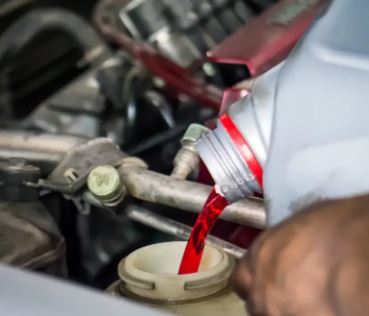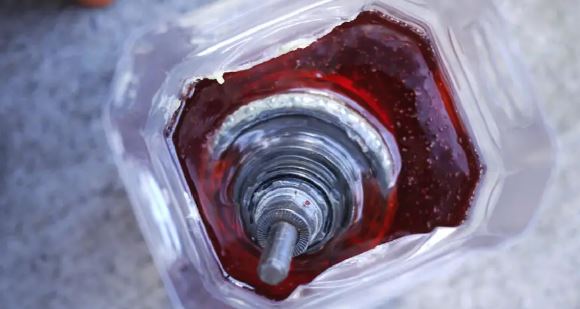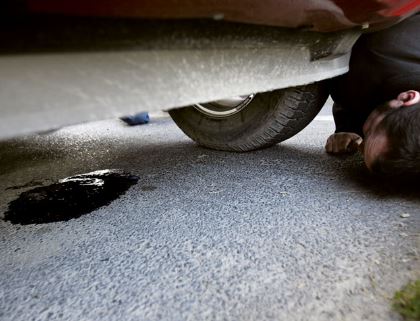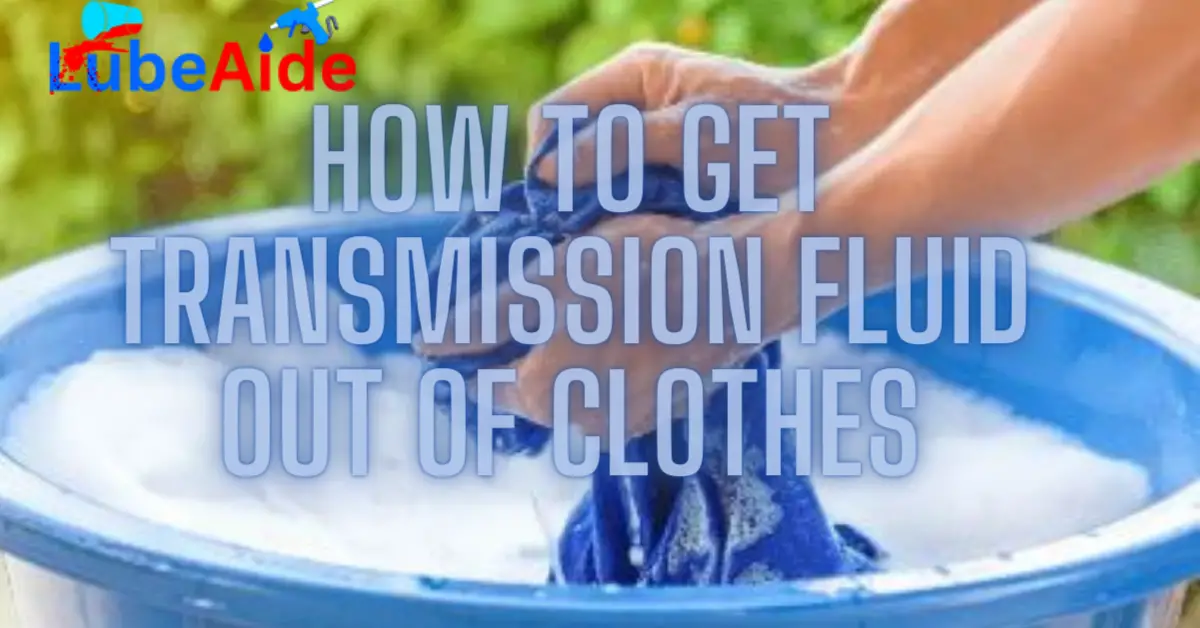You are aware of how messy it may become if you have ever worked on an automobile. Unfortunately, accidents happen, and it’s not uncommon for transmission fluid to spill onto your clothes while you’re working under the hood. But don’t worry, with the right techniques and materials, you can learn how to get transmission fluid out of clothes. You will find detailed methods and advice on how to successfully remove transmission fluid stains from clothing in this article. We have the solution for any accident or stain, no matter how big or tiny. So let’s get started and learn how to keep your clothes looking clean and fresh, no matter how messy the job gets.
Understanding Transmission Fluid

Transmission fluid is a crucial component of a vehicle’s transmission system. It is a kind of hydraulic fluid that is in charge of lubricating and cooling the different transmission components as well as supplying hydraulic pressure for gearshifting.
Transmission fluid typically has a red or pink color, and it is usually made up of a base oil, additives, and a viscosity modifier. The base oil is typically mineral oil or synthetic oil, and the additives are added to improve the fluid’s performance and protect the transmission from wear and tear. The viscosity modifier is added to ensure that the fluid maintains a consistent viscosity under different operating conditions.
A vehicle’s transmission system is made to move power from the engine to the wheels, and the transmission fluid is essential to this operation. It helps to reduce friction between the various components of the transmission, which can cause wear and tear over time. Additionally, transmission fluid helps to dissipate heat from the transmission, which can prevent overheating and damage to the transmission.
The type of transmission fluid needed for a given vehicle depends depend on the make, model, and type of transmission it has. There are various types of transmission fluid. Some vehicles require automatic transmission fluid, while others require manual transmission fluid. It is crucial to use the proper fluid because utilizing the incorrect type could harm the transmission.
It is important to maintain the transmission fluid at the correct level and to change it regularly. Over time, transmission fluid can become contaminated with dirt, debris, and other contaminants, which can reduce its effectiveness and potentially cause damage to the transmission. Changing the gearbox fluid is normally advised every 30,000 to 60,000 miles, however, this can fluctuate based on the car and the manufacturer’s guidelines.
Pre-Treatment Steps
Precautions before beginning the cleaning process:
- Avoid rubbing or scrubbing the stain vigorously as it can push the stain deeper into the fabric.
- Read the care label on your garment to ensure that the cleaning method you use is safe for the fabric.
- Wear gloves to protect your skin from any harsh chemicals.
Tools and materials needed:
- Paper towels or a clean cloth
- Dish soap or laundry detergent
- White vinegar
- Baking soda
- A soft-bristled brush or toothbrush
- Stain remover or pre-treatment spray
Tips on how to prepare the affected area:
- Blot the stain gently with a paper towel or clean cloth to remove any excess transmission fluid.
- Wait a few minutes after sparingly dabbing the stain with dish soap or laundry detergent.
- Apply a paste made of baking soda and water to a stain if it is very difficult to remove.
- For white or light-colored fabrics, you can use white vinegar to help remove the stain.
- Simply soak the infected area for 30 minutes in a bowl of cold water with one cup of white vinegar before cleaning.
How to Get Transmission Fluid Out of Clothes: Step-by-step Guide

Here is a how-to for eliminating transmission fluid stains from clothing:
- Act fast: The discoloration will be more difficult to remove the longer you wait. So, to start, wipe the stain to get rid of any extra oil with a clean cloth or paper towel.
- Pre-treat the stain: Apply a pre-treatment solution immediately to the afflicted area, such as dish soap or stain remover. Let it sit for a few minutes to allow the solution to penetrate the fabric.
- Wash the clothes: Wash the clothes in hot water using a laundry detergent that contains enzymes. This will help to break down the oil and remove the stain.
- Check the stain: After washing, check to see if the stain is completely removed. If not, repeat the process until the stain is gone.
When removing transmission fluid stains, it’s important to keep in mind that different types of fabrics require different treatment methods. For example, delicate fabrics such as silk require a more gentle approach. Here are some tips on how to treat different types of fabric:
- Cotton: Use a pre-treatment solution and wash in hot water.
- Polyester: Apply a pre-treatment solution and wash in warm water.
- Silk: Use a gentle pre-treatment solution and wash in cold water.
- Wool: Apply a pre-treatment solution and wash in cold water using a gentle detergent.
Lastly, it’s important to act quickly when dealing with transmission fluid stains. So, follow these time-sensitive cleaning tips:
- Blot the stain as soon as possible to remove excess oil.
- Apply a pre-treatment solution and let it sit for a few minutes before washing.
- Wash the clothes in the hottest water recommended for the fabric.
Alternative Cleaning Methods
In addition to traditional cleaning methods, there are alternative techniques you can use to get transmission fluid out of clothes. These methods may involve other cleaning agents and solutions that are more readily available in your household or homemade remedies that can effectively remove the stains.
One common household cleaning agent that can be effective is dish soap. Just dab a little dish soap over the stain, allow it to soak for a few minutes, and then wash the clothing as usual. Another effective solution is white vinegar, which can be applied to the stain before washing to help break it down.
Homemade remedies for removing transmission fluid stains may include a combination of baking soda and hydrogen peroxide or a mixture of lemon juice and salt. These solutions can be applied directly to the stain and left for some time before washing.
It’s important to keep safety precautions in mind when using alternative cleaning methods. Always read labels and follow instructions carefully to avoid harming yourself or your clothing. Additionally, test any new cleaning solution on a small, inconspicuous area of the clothing before applying it to the entire stain.
Using alternative cleaning methods and solutions, you can effectively remove transmission fluid stains from your clothes using materials readily available in your household. Just be sure to exercise caution and take necessary safety measures to protect both yourself and your clothing.
Preventing Transmission of Fluid Stains

- Wear appropriate clothing: When working on a car, wear clothes that cover your skin and are made of materials that can withstand spills and stains. Avoid loose clothing that can get caught in machinery.
- Use protective gear: Wear gloves, goggles, and a face mask to protect yourself from exposure to transmission fluid and other hazardous chemicals.
- Cover the car: Use a plastic sheet or an old blanket to cover the car’s engine and transmission before starting any work. This will prevent transmission fluid from splattering onto your clothes.
- Be careful when adding fluid: When adding transmission fluid, use a funnel to prevent spills. Wipe off any excess fluid immediately using a clean rag.
- Clean up spills immediately: If you do spill transmission fluid on your clothes, act quickly. Use a clean rag to blot up the excess fluid, and then follow the steps outlined in our guide to remove the stain.
Post-Cleaning Care
Drying techniques and methods:
- Avoid using a clothes dryer to dry the affected clothing, as heat can set any remaining stains into the fabric.
- Instead, hang the clothing to air dry, ideally outside in direct sunlight, as the UV rays can help break down any remaining stains.
How to inspect and ensure complete removal of stains:
- Before storing the clothing away, inspect the area where the stain was located to ensure that it has been completely removed.
- If there is still a residual stain, repeat the cleaning process or consider seeking professional help to remove the remaining stain.
Tips for maintaining clothing quality after cleaning:
- After removing the stain, wash the clothing using a mild detergent to ensure that any remaining cleaning agents are removed from the fabric.
- Avoid using bleach or harsh chemicals, as these can damage the clothing fibers and shorten the lifespan of the fabric.
- If possible, hand wash the clothing to minimize wear and tear.
- Store the clothing in a dry, cool, and dark place to prevent mold and mildew from forming.
FAQs About Removing Transmission Fluid Out of Clothes
What should I do if I spill transmission fluid on my clothes?
If you spill transmission fluid on your clothes, it’s important to act quickly. Use a clean cloth or paper towel to blot the stain, being careful not to spread it further. Avoid rubbing the stain, as this can push the fluid deeper into the fabric.
What household items can I use to remove transmission fluid stains?
There are several household items that can be effective at removing transmission fluid stains, including dish soap, baking soda, and vinegar. You can also use a pre-treatment stain remover or laundry detergent.
How do I remove transmission fluid stains with dish soap?
To remove transmission fluid stains with dish soap, first, blot the stain with a clean cloth to remove any excess fluid. Next, use your fingers or a soft-bristled brush to apply a little quantity of dish soap directly to the stain and work it into the cloth. Rinse the area with cool water after letting the soap stay on the stain for 10 to 15 minutes.
How do I remove transmission fluid stains with baking soda and vinegar?
To remove transmission fluid stains with baking soda and vinegar, first, blot the stain with a clean cloth to remove any excess fluid. Then, combine a paste of baking soda and water in equal parts, and use it to cover the stain. After 15-20 minutes of letting the paste stay on the stain, rinse the area with lukewarm water. The stain should then be treated with a tiny amount of vinegar and let stay for 5 to 10 minutes before being rinsed again with cool water.
Can I use bleach to remove transmission fluid stains?
Bleach is not recommended for removing transmission fluid stains, as it can react with the fluid and make the stain worse. It can also damage the fabric and cause discoloration.
Should I wash the clothes in hot or cold water?
It’s best to wash clothes with transmission fluid stains in cold water, as hot water can set the stain and make it more difficult to remove. Make sure to read the care label on the clothes before washing them to ensure that cold water is safe for the fabric.
Can a professional cleaner remove transmission fluid stains?
If you’re unable to remove the transmission fluid stains yourself, a professional cleaner may be able to help. Be sure to tell them what type of fabric the clothes are made of and what type of transmission fluid was spilled to ensure that they use the correct cleaning method.
Final Thought
In the end, knowing how to get transmission fluid out of clothes is an essential skill for anyone who works with cars or handles transmission fluid. Prompt action is crucial to prevent the stain from setting, and the appropriate cleaning method can help save your clothes from permanent damage. By following the steps outlined in this ultimate guide, you can effectively remove transmission fluid stains and prevent them from happening again. Remember to always prioritize safety when working with transmission fluid and take necessary precautions to avoid accidents. With the right tools, techniques, and knowledge, you can restore your clothes to their former glory and save money in the process.
Related Topics:
- Do Manual Transmissions Have Fluid
- Can Low Transmission Fluid Cause Overdrive Light to Flash
- Does Transmission Fluid Evaporate
- How to Get Transmission Fluid Out of Clothes
- Can Transmission Fluid Freeze
- Will Transmission Fluid Clean Diesel Fuel Injectors
- Can You Mix Synthetic Transmission Fluid With Regular Transmission Fluid
- Automatic Transmission High RPM Before Shifting
- Does Transmission Fluid Expire
- Can You Start an Engine Without Transmission Fluid


